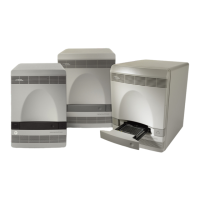DRAFT
September 25, 2007 1:07 am, 4376782_Glossary.fm
Glossary
145
Applied Biosystems StepOne
™
and StepOnePlus
™
Real-Time PCR Systems
Installation, Networking, and Maintenance Guide
CONFIDENTIAL — For AB Internal Use Only. Do Not Distribute.
reaction mix A solution that contains all components to run the PCR reaction, except for the template
(sample, standard, or control).
reagents The PCR reaction components you are using to amplify the target and to detect
amplification. Types of reagents used on the StepOne
™
and StepOnePlus
™
systems:
•TaqMan
®
reagents
•SYBR
®
Green reagents
• Other reagents
real-time PCR Process of collecting fluorescence data during PCR. Data from the real-time PCR are used
to calculate results for quantitation experiments or to troubleshoot results for genotyping
or presence/absence experiments.
reference sample In relative standard curve and comparative C
T
(∆∆C
T
) experiments, the sample used as the
basis for relative quantitation results. Also called the calibrator.
refSNP ID Identifies the reference SNP (refSNP) cluster ID. Generated by the Single Nucleotide
Polymorphism Database of Nucleotide Sequence Variation (dbSNP) at the National
Center for Biotechnology Information (NCBI). The refSNP ID can be used to search the
Applied Biosystems Store for an Applied Biosystems SNP Genotyping Assay. Also
called an rs number.
regression
coefficients
Values calculated from the regression line in standard curves, including the R
2
value,
slope, and y-intercept. You can use the regression coefficients to evaluate the quality of
results from the standards. See also standard curve.
regression line In standard curve and relative standard curve experiments, the best-fit line from the
standard curve. Regression line formula:
C
T
= m [log (Qty)] + b
where m is the slope, b is the y-intercept, and Qty is the standard quantity.
See also regression coefficients.
reject well An action that the software performs during analysis to remove one or more wells from
further analysis if a specific flag is applied to the well. Rejected wells contain results
calculated up to the point of rejection.
relative standard
curve method
Method for determining relative target quantity in samples. With the relative standard
curve method, the StepOne
™
software measures amplification of the target and of the
endogenous control in samples, in a reference sample, and in a standard dilution series.
Measurements are normalized using the endogenous control. Data from the standard
dilution series are used to generate the standard curve. Using the standard curve, the
software interpolates target quantity in the samples and in the reference sample. The
software determines the relative quantity of target in each sample by comparing target
quantity in each sample to target quantity in the reference sample.
Remote Monitor A feature in the StepOne
™
software that allows you to monitor a StepOne
™
or
StepOnePlus
™
instrument over the network. With the Remote Monitor, you can monitor
the instrument status, send an experiment to the instrument, monitor amplification plots
and temperature plots in real time, and download the results to your computer. You cannot
operate the StepOne
™
or StepOnePlus
™
instrument using the Remote Monitor.
